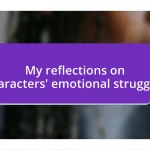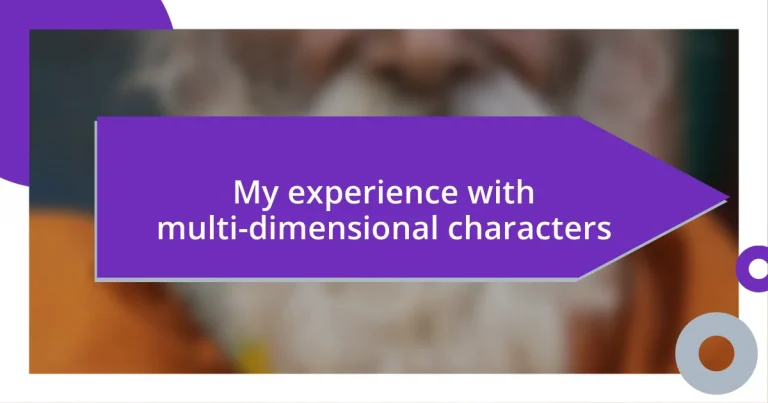Key takeaways:
- Multi-dimensional characters enhance empathy and authenticity, making them relatable and fostering deeper emotional connections with the audience.
- Developing character depth involves creating strong backstories, exploring internal conflicts, and balancing strengths and weaknesses to enrich narratives.
- Analyzing characters in popular media reveals transformative arcs and complex relationships, prompting reflections on personal experiences and societal issues.
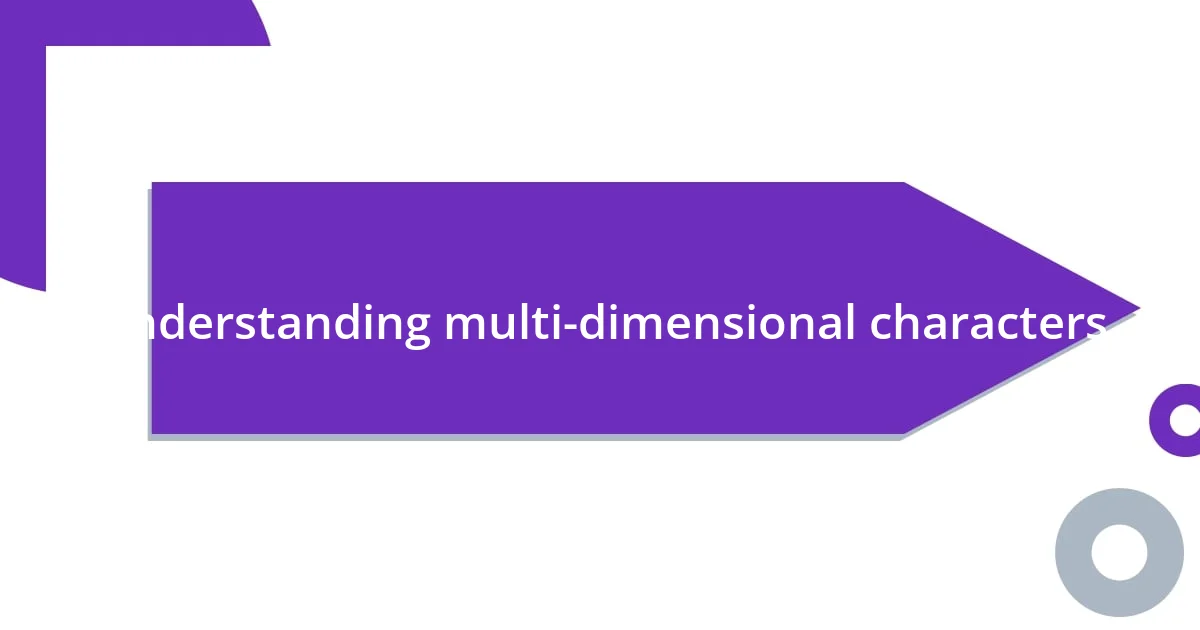
Understanding multi-dimensional characters
Multi-dimensional characters are those that possess a variety of traits, motivations, and backgrounds, making them complex and relatable. I remember reading a book where the protagonist struggled with guilt over past decisions. This internal conflict added depth to their personality and kept me turning the pages—how often do we see ourselves in characters who grapple with their flaws?
When I think of multi-dimensional characters, I often wonder: what makes them resonate with us? It boils down to the nuances in their lives. For instance, a character’s fear of failure intertwined with a drive for success creates a fascinating tension. This reminds me of a friend who excelled academically but felt unworthy despite their achievements; such layers enrich a character’s journey.
Creating these complexities isn’t just about backstory; it’s about how characters grow through challenges. I recall a movie where a villain underwent a surprising transformation, revealing their reasoning behind their antagonist role. It sparked my realization: aren’t we all a mix of light and dark, capable of change? Exploring these dimensions helps us relate, reflect, and sometimes even heal through the stories we consume.
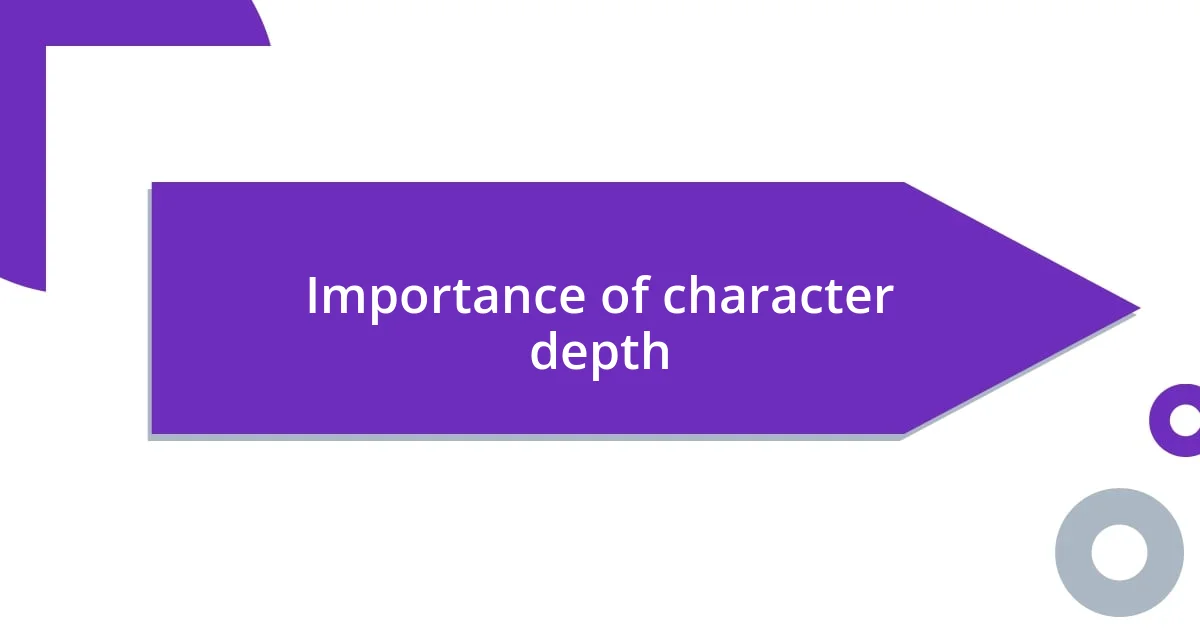
Importance of character depth
Character depth is crucial because it cultivates empathy. When a character faces dilemmas that evoke real emotions, I often find myself emotionally invested in their journey. I remember watching a series where a seemingly selfish character revealed their trauma, making me rethink my initial judgment. This process shows that in getting to know these characters, we also uncover parts of ourselves.
Moreover, characters with depth often spark deeper discussions. Take, for example, a film featuring a strong female lead who battles societal expectations while chasing her dreams. Her struggles resonated with me, prompting conversations with friends about the pressures we face in our lives. It’s fascinating how characters can become vessels for shared experiences, driving connection and understanding among viewers.
Ultimately, the rich tapestry of a multi-dimensional character lays the groundwork for authenticity. My favorite books are those where I can feel the character’s vulnerabilities—like an old novel about a lonely artist seeking acceptance. That character’s hardships mirrored my own insecurities, and I believe that’s where true storytelling power lies. When we dive deeper, we not only enrich the narrative but also enhance our capacity for connection.
| Aspect | Importance |
|---|---|
| Empathy | Engages the reader by connecting them emotionally. |
| Discussion | Fosters deeper conversations and reflections on personal experiences. |
| Authenticity | Creates a realistic portrayal that resonates with the audience. |
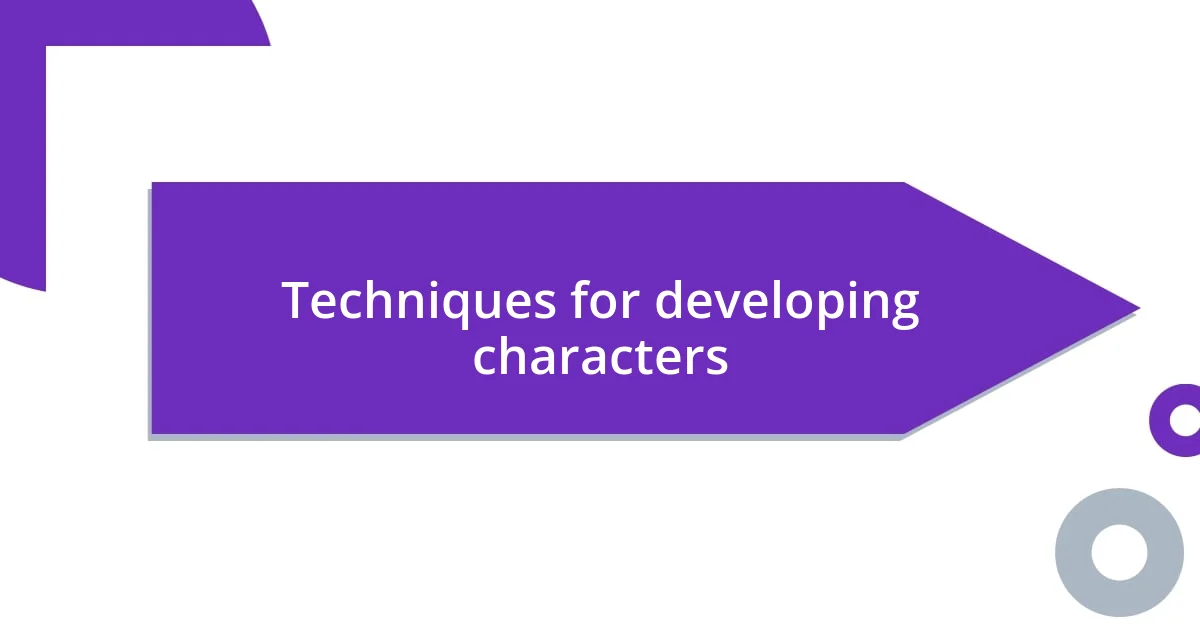
Techniques for developing characters
To develop multi-dimensional characters, I find that creating strong backstories is crucial. Understanding a character’s history can illuminate their motivations and fears. I once crafted a character who appeared confident in social situations but struggled with loneliness stemming from a turbulent childhood. This juxtaposition shaped how I wrote their interactions, highlighting their vulnerabilities and making them relatable.
Here are some techniques that work well for me when developing character depth:
- Flaws and Strengths: Infuse characters with a mix of imperfections and admirable qualities. I love characters who are both heroic and deeply flawed; it makes their journey more compelling.
- Dynamic Relationships: Introduce diverse relationships that challenge the character. I’ve written friendships that test loyalties, leading to significant growth or breakdowns.
- Internal Conflicts: I enjoy exploring characters’ internal struggles, allowing readers to witness their multifaceted emotions. A character grappling with a moral dilemma can create a profound connection with the audience.
- Visual Symbols: Sometimes, I give characters an item or trait that symbolizes their journey. For example, a character who carries an old photograph can reflect their longing for a lost past, resonating deeply with readers.
By employing these techniques, I ensure that the characters resonate with my own life experiences while allowing readers to see pieces of themselves within the narrative.
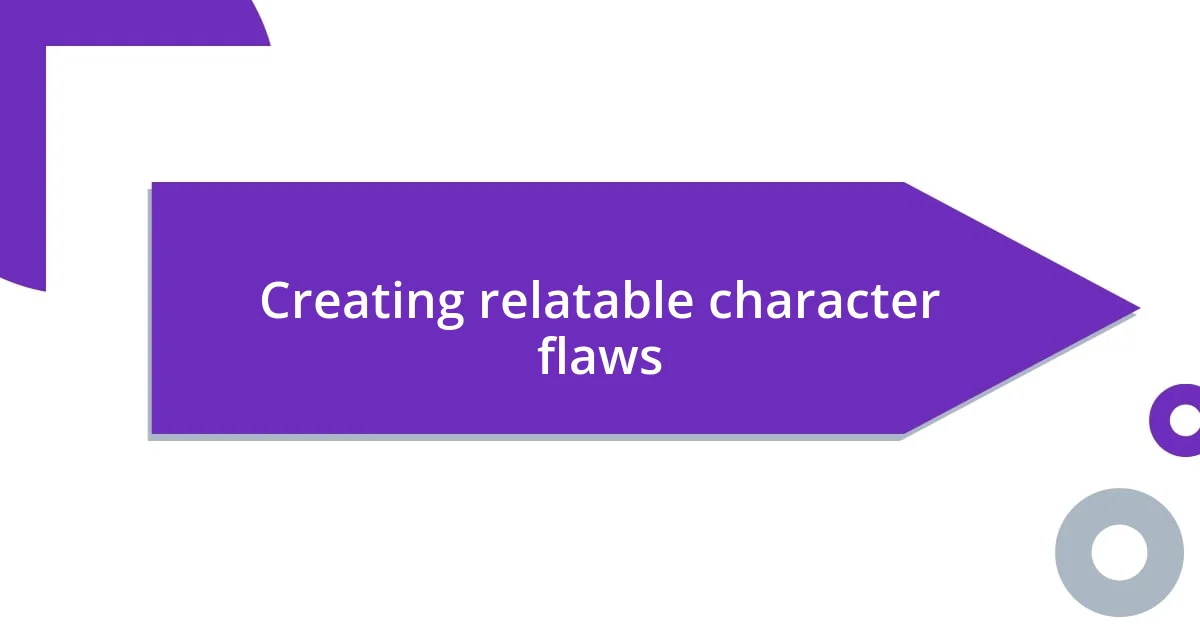
Creating relatable character flaws
Creating relatable character flaws requires a balance between authenticity and relatability. When I think about flaws, I often lean toward imperfections that remind me of myself or people I know. For instance, I once developed a character who struggled with procrastination. This trait, which often leads to missed opportunities, is something I’ve grappled with too. By sharing their journey, readers can connect with that very human experience of feeling overwhelmed.
Another technique that resonates with me is revealing vulnerabilities tied to a character’s flaws. I remember crafting a character who presented a tough exterior, yet inside, they feared rejection because of their past failures. This duality not only humanized them but also encouraged readers to reflect on their own fears. Isn’t it fascinating how our insecurities can unite us, making characters feel more real?
Additionally, I find that humor can be an effective tool for portraying flaws while keeping readers engaged. An example from my writing is a character who always found themselves in awkward situations due to their bluntness. Their hilarious misadventures showcased their lack of social finesse, yet it also opened doors to deeper reflections about kindness and authenticity. By weaving humor into flaws, I create a space for empathy, inviting readers to laugh with, rather than just at, the characters.
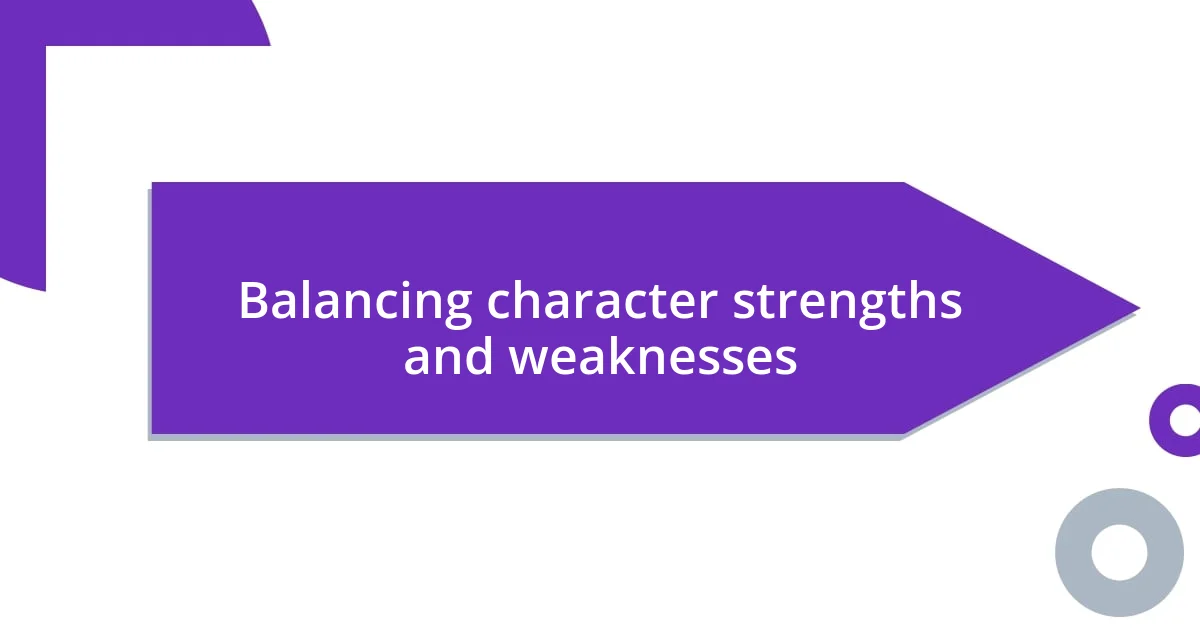
Balancing character strengths and weaknesses
Balancing strengths and weaknesses in characters is crucial for crafting someone that feels real. I remember creating a character who was a brilliant strategist but couldn’t connect with others emotionally. This dichotomy made them incredibly complex. It allowed me to explore how their intelligence both isolated and empowered them during critical moments. Have you noticed how a character’s strengths can sometimes become their Achilles’ heel?
When I write, I strive to ensure that a character’s strengths don’t overshadow their weaknesses. For instance, I once worked on a character who excelled in sports but dealt with crippling self-doubt. That internal tug-of-war shaped their decisions, providing rich ground for development and exploration. Seeing them battle both public accolades and private struggles created a more engaging narrative, inviting readers to reflect on their own insecurities.
I also find that the interplay of strengths and weaknesses can bring moments of unexpected revelation. There was a character in one of my stories who was fiercely independent yet deeply afraid of being alone. This contradiction led to some profound moments of growth and vulnerability. It made me wonder—don’t we all have those parts of ourselves that seem at odds? By exposing these complexities, I let the readers witness the character’s journey towards self-acceptance, which can be both enlightening and relatable.
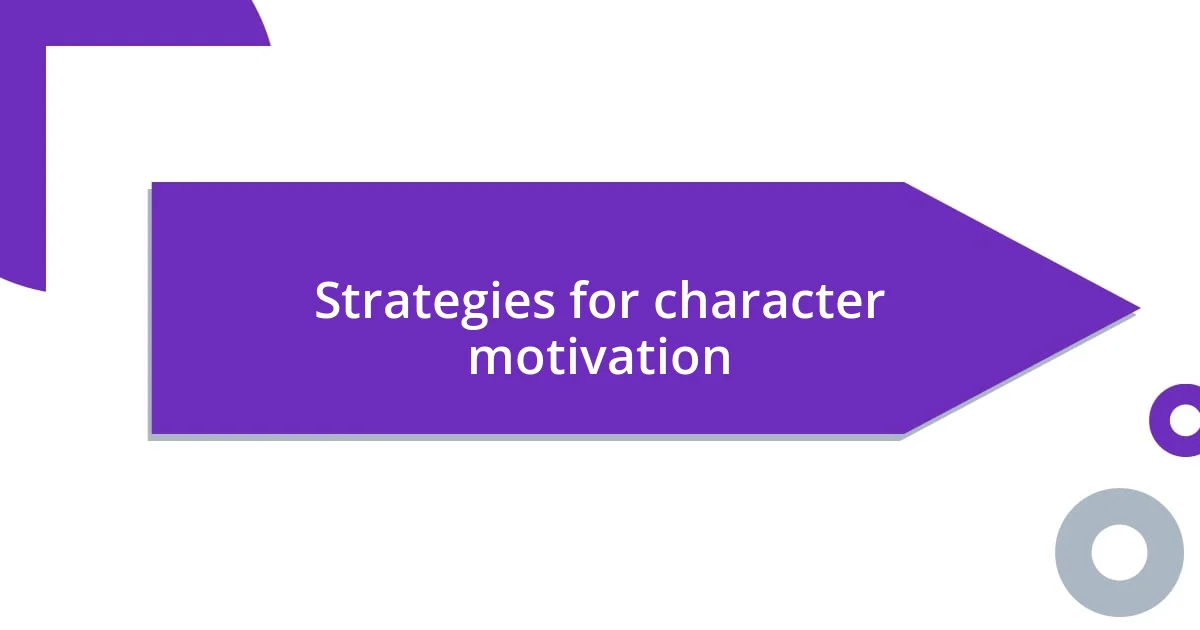
Strategies for character motivation
Understanding what drives my characters can make a significant difference in how relatable and compelling they are. I remember a particular character I created, whose relentless pursuit of perfection stemmed from childhood pressure from their parents. This backstory not only motivated their actions but also brought depth to their struggles. Does anyone else see a piece of themselves in the quest for an unattainable ideal?
Another strategy I find effective is tying a character’s motivations to their relationships. I developed a character whose fierce protectiveness over their sibling pushed them to the brink of recklessness. This motivation added layers to their personality and created tension, as their love often clashed with common sense. It’s intriguing how relationships can propel characters into both heroic and disastrous paths, isn’t it?
Lastly, I always aim to show how a character’s environment influences their choices and motivations. I once crafted a protagonist who grew up in a small town where dreams felt stifled. Their desire to break free led them to make daring decisions that changed the course of their life. By highlighting their surroundings, I found a genuine way to reflect the struggle between aspiration and circumstance. Isn’t it fascinating how our environments shape who we become?
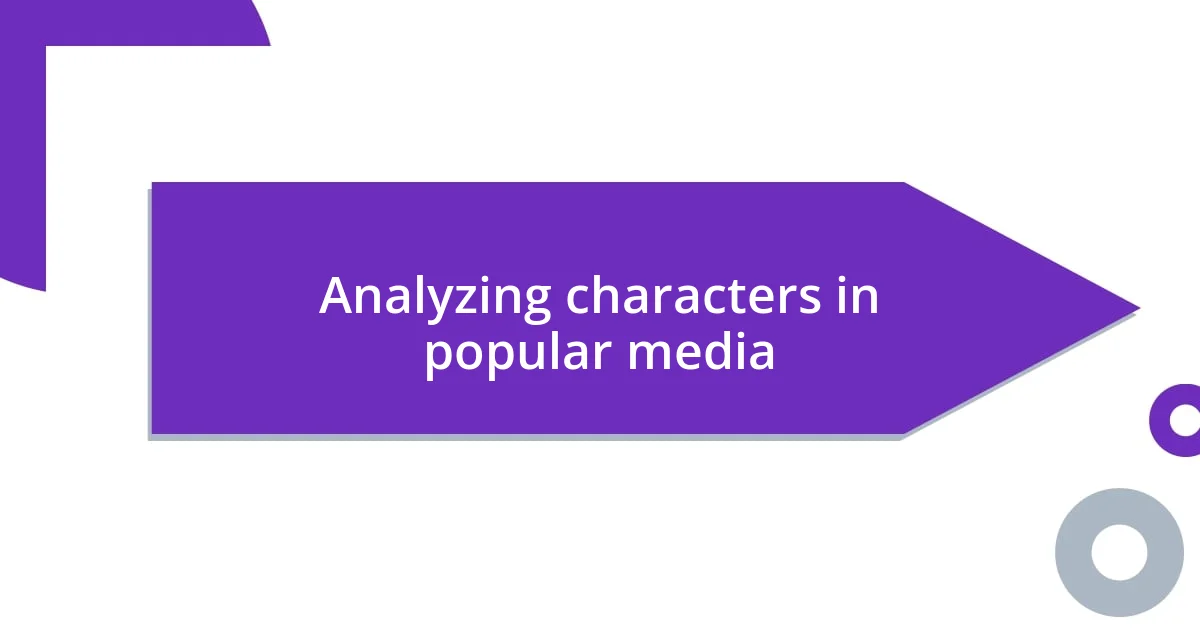
Analyzing characters in popular media
When I analyze characters in popular media, I often focus on their transformative arcs. I recall watching a film where the protagonist started as a selfish, power-hungry individual. Their journey towards selflessness, often triggered by small acts of kindness from others, struck a chord with me. It begs the question: do we all have the capacity to change, even when circumstances seem stacked against us?
A nuanced character is frequently defined by their relationships. I remember dissecting a series known for its layered characters, where each relationship revealed different facets of their personalities. One character, who seemed cold and unapproachable, turned out to be deeply loyal and protective towards their friends. This complexity made me reflect—how many times do we misjudge someone based on first impressions alone?
In television, character motivations can often be tied to social issues, which adds a rich layer of depth. There’s a show I enjoyed that featured a character grappling with their identity in a restrictive society. Their internal struggles and the external pressures they faced resonated with me because it highlighted how personal experiences shape our views and actions. Isn’t it profound how stories allow us to explore these intricate dynamics?










